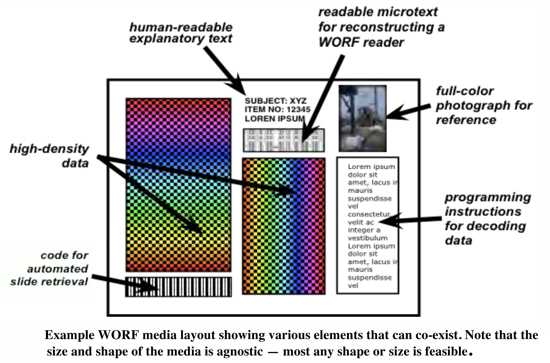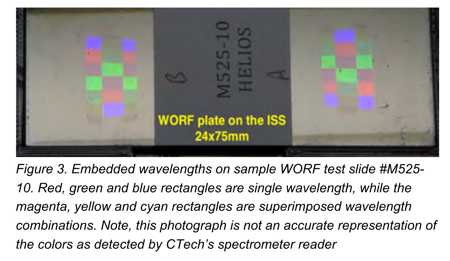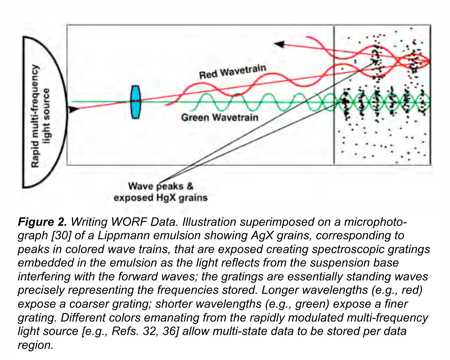yet2 Offers Licences of Write Once, Read Forever Permanent Digital Data Archiving Technology from Wave Domain
Stores fully-intact and preserved data for hundreds of years with zero potential of erasure, corruption or hacking.
This is a Press Release edited by StorageNewsletter.com on July 12, 2023 at 2:01 pmWave Domain LLC has chosen yet2, to license its WORF (Write Once, Read Forever) permanent archiving technology.
WORF is a game-changing data writing, storing, reading, and protecting technology that preserves digital data permanently, and in a way that is far more economically and environmentally sustainable than any known storage system. More specifically, WORF stores fully-intact and preserved data for many hundreds of years with zero potential of erasure, corruption or hacking. Because WORF media never needs to be re-written or replaced and requires no energy-consuming environmental controls, WORF saves more than 80% of total media and energy costs and reduces archiving-associated carbon footprint by over 90% compared to the best archival media in use today.

How is this possible?
According to Richard Solomon, WORF co-inventor and co-founder/CTO, Wave Domain: “WORF re-purposes and combines two amazing technologies… We discovered that a 130-year-old Nobel Prize winning breakthrough (NDLR: Gabriel Lippmann) used to create the first color photographs using stored light waves can be repurposed to produce media that store data. Colored light exposes photo-reactive molecules in the media, converting them into fixed, physical representations of each color’s wavelength…without dyes. Three bytes of data are stored per location (vs. one bit per location for other media). The exposed WORF Media is set permanently, it cannot be erased or changed, and it never fades.“
“WORF Drive is a new way of writing data using controlled colored light and common, inexpensive electronic components used in billions of widely available devices today. Firmware reads digital data (of all types) and configures it for storing in color format; it instructs the system components to illuminate the light-sensitive media with chosen colors, thereby controlling the wavelengths stored in each pixel location. Once written to the media, WORF Drive can read the data using the key elements of the recording algorithms, in reverse, reconstituting the original digital data perfectly.”
The inventors, along with DARPA, NASA and other U.S. government agencies have invested several million dollars in demonstrating and proving out each element of WORF media and WORF Drive. In fact, it was WORF media that was tested by NASA on the International Space Station (ISS) for the HELIOS (Hardened Extremely Long-Life Information Optical Storage) project…an 8-month mission, splashing down in January 2020, validating that WORF media survives ‘all critical parameters for harsh space-based environments, including microgravity and ionizing radiation.’

WORF is patent protected, with additional IP pending. WORF is not yet a fully functional product. Product development is straightforward and not terribly costly.
Wave Domain seeks to license its WORF technology, IP and know-how to one or more firms having a strategic commitment to permanent data archiving. The inventors will be available to provide the technical support needed to produce a product.
Eric Rosenthal, WORF co-inventor and co-founder and CEO, Wave Domain, summed-up the WORF value proposition in this way; “We have worked long and hard on creating a permanent digital archiving media and reader/writer system that solves the problem of storing large amounts of digital data in perpetuity at low cost. The ever-increasing volume of data archived by corporate, governmental and historical organizations cannot be sustained using impermanent, costly, and energy-consuming magnetic media and cloud storage. Permanent storage and certain accessibility are in jeopardy and both the cost and the environmental impact are unsustainable. WORF is the only truly immutable archival data storage technology. And, we are thrilled, in 2023, to make it available for license to the industry.”
Bob Miller, VP, yet2, commented: “Only the inventors from Wave Domain, with their specific and complementary knowledge and experience, could have conceived and demonstrated this brilliant, elegant solution to the evolving crisis befalling those needing to keep treasured data safely stored at low cost in perpetuity. At yet2, our job is to make sure we reach the future leaders and champions for WORF and share its value proposition and the wide-ranging commercial opportunity it represents.”
About Wave Domain
It has been in deep stealth mode. Its team of inventors, individually and together, apply their knowledge of electronics, physical chemistry, storage, wave-based imaging and human vision, have a rich track record of inventing and developing foundational, enabling, hugely impactful technologies used every day in high-definition TV, magnetic data storage, voice-over-IP, broadcasting and reflective signage. Over recent years, it invented, demonstrated, de-risked and protected WORF technology. Now it seek sto license the technology to visionaries seeking practical, economically and environmentally sustainable solutions for very long-term data archiving.
About yet2
It operates at the hub of global technology innovation. Since 1999, it has been an Open Innovation services company. Leveraging its global network of affiliates, Global 1000 corporate clients, its large proprietary database of promising start-ups and solution providers, and its offices in North America, Europe and Asia, it provides hands-on open innovation services to clients across the globe. It specializes in technology scouting in a variety of forms (topic specific deep search, strategic deal flow, innovation tours, OI portal management and OI training) and in technology licensing. Over the years, it has brought hundreds of millions of dollars in value to its clients in life sciences and consumer health, industrial/chemicals/materials, electronics, aerospace/defense, digital/big data, oil/gas and energy, and food/beverage.
Comments
A lot of literature can be found on these website links:
US patents:
Write once read forever archival data storage
Rosenthal, Eric Dean, Morganville, NJ, Solomon, Richard Jay, Monson, MA, Johnson, Clark Eugene, Madison, WI, Solomon, Brian David, Monson, MA, and Smith, Jonathan Michael, Princeton, NJ, has been assigned a patent (9330706), for a "write once read forever archival data storage."
The abstract of the patent published by the U.S. Patent and Trademark Office states: "This invention teaches a methodology and an optical apparatus that provides long-term, archival storage using a chemically stable, high-resolution, photosensitive emulsion, such as silver halide, for the long-term, archival storage and retrieval of data, images and text. Multiple state data substantially increasing data density is stored as vertical diffraction gratings in the archival photosensitive emulsion. The data can be read out in parallel, substantially increasing retrieval speeds beyond that of current optical and magnetic techniques.”
The patent application was filed on 2014-09-30 (14/121635).
Wave-based optical data storage
Rosenthal, Eric Dean, Morganville, NJ, Solomon, Richard Jay, Monson, MA, and Johnson, Clark Eugene, Madison, WI, has been assigned a patent (8891344), for a "wave-based optical data storage."
The abstract of the patent published by the U.S. Patent and Trademark Office states: "The invention combines several techniques applying high-resolution photosensitive emulsions for the long-term, archival storage of data, images and text. Data is stored as vertical interference patterns of multiple frequencies in a photographic emulsion. Read-out of the stored data uses a precision mechanism to locate and decode stored data.”
The patent application was filed on 2012-05-29 (13/506970).
Software defined lensing
Rosenthal, Eric Dean, Morganville, Solomon, Richard Jay, Monson, MA, Smith, Jonathan M., Princeton, NJ, and Johnson, Clark Eugene, Madison, WI, has been assigned a patent (8507836), for a "software defined lensing."
The abstract of the patent published by the U.S. Patent and Trademark Office states: "The invention relates to imaging devices and methods, pertinent to electromagnetic energy in visual and other spectra, to capture and reproduce substantially all image information in a relevant spectrum through all-electronic sensors and electronic computation means.”
The patent application was filed on 2012-05-07 (13/506649).
Electromagnetic spectral-based imaging devices and methods
Rosenthal, Eric Dean, Morganville, NJ, Solomon, Richard Jay, Monson, MA, and Johnson, Clark Eugene, Waunakee, WI, has been assigned a patent (7521680), for "electromagnetic spectral-based imaging devices and methods."
The abstract of the patent published by the U.S. Patent and Trademark Office states: "This invention teaches how to fabricate a new type of full-spectra wavelength detector and spectrum analyzer in the form of antennas that make use of the wave properties of light. The detector's frequency detection range is controlled through the fabrication process. By miniaturizing the antenna detectors to the nanometer range and arranging them in an array a unique, full-spectrum imaging sensor is created.”
The patent application was filed on 2004-11-30 (10/999741).
Full spectrum color detecting pixel camera
Rosenthal, Eric, Morganville, NJ, Solomon, Richard Jay, Monson, MA, and Johnson, Clark, Waunakee, WI, has been assigned a patent (7437000), for a "full spectrum color detecting pixel camera."
The abstract of the patent published by the U.S. Patent and Trademark Office states: "This invention comprises the means for the capture of full spectrum images in an electronic camera without the use of color primary filters to limit the spectral color gamut of the captured image. The fundamental principle of the invention is that each pixel of the image sensor acts as an independent spectrophotometer and spectral separator. Electromagnetic energy enters though a slit or collimating optic. Electromagnetic energy gets diffracted into component spectra by diffraction grating spectrophotometer for each pixel of image Electromagnetic energy leaves diffraction grating at different angles based on wavelength of the energy Spectrophotometer separates light for each pixel into its spectral components onto photodetector line array elements. Individual line array elements which are activated determine the original radiance level of the light source containing that specific wavelength region. The sum of these regions determines the spectral signature of the light at that pixel element. Many pixels arranged in a two-dimensional matrix would generate the image frame. Sequencing frame yields a full-spectrum moving image.”
The patent application was filed on 2004-03-11 (10/798159).















 Subscribe to our free daily newsletter
Subscribe to our free daily newsletter

